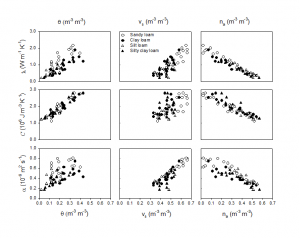13.2 Soil Thermal Properties
The primary thermal properties of soil, or any substance, are the heat capacity and the thermal conductivity. The heat capacity can be defined per unit mass, in which case it is often called the specific heat, or per unit volume, in which case it is called the volumetric heat capacity. Sometimes it is useful to consider the ratio of the thermal conductivity to the volumetric heat capacity, and this ratio is called the thermal diffusivity. We will define and consider each of these in turn below. Knowledge of the soil thermal properties is necessary to predict how soil temperatures vary in space and time. Sensors which measure soil thermal properties can be used monitor soil water content nondestructively. Soil thermal properties also play a role in several remote-sensing based approaches for estimating soil moisture across large regions.
13.2.1 Thermal Conductivity
The soil thermal conductivity (λ) is the ratio of the magnitude of the conductive heat flux through the soil to the magnitude of the temperature gradient (W m-1 °C-1). It is a measure of the soil’s ability to conduct heat, just as the hydraulic conductivity is a measure of the soil’s ability to “conduct” water. Soil thermal conductivity is influenced by a wide range of soil characteristics including:
- air-filled porosity
- water content
- bulk density
- texture
- mineralogy
- organic matter content
- soil structure
- soil temperature
Among common soil constituents, quartz has by far the highest thermal conductivity and air has by far the lowest thermal conductivity (Table 13‑1) [8] [9]. Often, the majority of the sand-sized fraction in soils is composed primarily of quartz, thus sandy soils have higher thermal conductivity values than other soils, all other things being equal. Since the thermal conductivity of air is so low, air-filled porosity exerts a dominant influence on soil thermal conductivity. The higher the air-filled porosity is, the lower the thermal conductivity is (Fig. 13‑4). Soil thermal conductivity increases as water content increases, but not in a purely linear fashion. For dry soil, relatively small increases in the water content can substantially increase the thermal contact between mineral particles because the water adheres to the particles, resulting in a relatively large increase in the thermal conductivity.
Table 13‑1. Thermal conductivity, density, and specific heat of common soil constituents at 10 °C (after de Vries, 1963, Table 7.1; adapted from Horton and Ochsner, 2011).
| Soil constituent | Thermal conductivity |
Density |
Specific heat |
| W m-1 °C -1 | g cm-3 | J g-1 °C -1 | |
| Quartz | 8.8 | 2.66 | 0.75 |
| Clay minerals | 3 | 2.65 | 0.76 |
| Soil organic matter | 0.3 | 1.3 | 1.9 |
| Water | 0.57 | 1.00 | 4.18 |
| Ice (0 °C) | 2.2 | 0.92 | 2.0 |
| Air | 0.025 | 0.00125 | 1.0 |

13.2.2 Heat Capacity
Soil volumetric heat capacity (C) is the amount of energy required to raise the temperature of a unit volume of soil by one degree (J m-3 °C-1). Unlike thermal conductivity, volumetric heat capacity increases strictly linearly as soil water content increases (Fig. 13‑4). Volumetric heat capacity is also a linear function of bulk density. The volumetric heat capacity can be calculated by
![]()
(Eq. 13-2)
where ρb is the soil bulk density (g cm-3), cs is the specific heat of the soil solids (J g-1 °C-1), ρw is the density of water (g cm-3), cw is the specific heat of water, and θ is the volumetric water content (cm3 cm-3). To increase the temperature of wetter, denser soil requires more energy than to increase the temperature of drier, less dense soil, which has a lower volumetric heat capacity. This is one factor that can contribute to lower soil temperatures and delayed crop development in soils managed with no tillage [10].
13.2.3 Thermal Diffusivity
The soil thermal diffusivity is the ratio of the thermal conductivity to the volumetric heat capacity (m2 s-1). It is an indicator of the rate of at which a temperature change will be transmitted through the soil by conduction. When the thermal diffusivity is high, temperature changes are transmitted rapidly through the soil. Logically, soil thermal diffusivity is influenced by all the factors which influence thermal conductivity and heat capacity. Thermal diffusivity is somewhat less sensitive to soil water content than are thermal conductivity and volumetric heat capacity (Fig. 13‑4). The thermal diffusivity is a particularly useful parameter to aid in understanding and modeling soil temperatures, which is the next topic we will consider.

